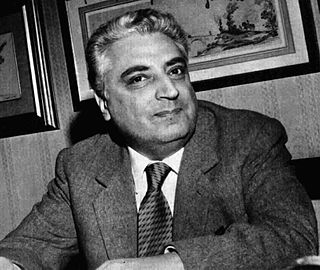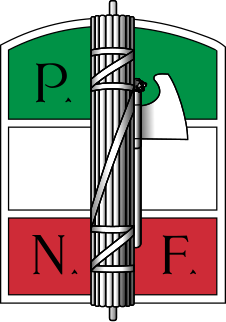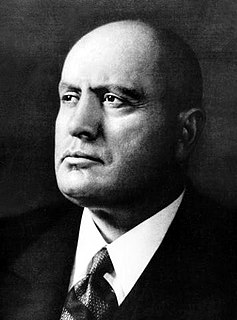Related Research Articles

Fascism is a form of far-right, authoritarian ultranationalism characterized by dictatorial power, forcible suppression of opposition, and strong regimentation of society and of the economy, which came to prominence in early 20th-century Europe. The first fascist movements emerged in Italy during World War I, before spreading to other European countries. Opposed to liberalism, democracy, Marxism, and anarchism, fascism is placed on the far right within the traditional left–right spectrum.

Gaetano Salvemini was an Italian antifascist politician, historian and writer. Born in a family of modest means, he became an acclaimed historian both in Italy and abroad, particularly in the United States, after he was forced into exile by Mussolini's fascist regime.
Clerical fascism is an ideology that combines the political and economic doctrines of fascism with clericalism. The term has been used to describe organizations and movements that combine religious elements with fascism, receive support from religious organizations which espouse sympathy for fascism, or fascist regimes in which clergy play a leading role.
The economy of fascist Italy refers to the economy in the Kingdom of Italy between 1922 and 1943, under fascism. Italy had emerged from World War I in a poor and weakened condition and, after the war, suffered inflation, massive debts and an extended depression. By 1920, the economy was in a massive convulsion, with mass unemployment, food shortages, strikes, etc. That conflagration of viewpoints can be exemplified by the so-called Biennio Rosso.

Renzo De Felice was an Italian historian, who specialized in the Fascist era, writing, among other works, a 6000-page biography of Mussolini. He argued that Mussolini was a revolutionary modernizer in domestic issues but a pragmatist in foreign policy who continued the Realpolitik policies of Italy from 1861 to 1922. Historian of Italy Philip Morgan has called De Felice's biography of Mussolini "a very controversial, influential and at the same time problematic re-reading of Mussolini and Fascism" and rejected the contention that his work rose above politics to "scientific objectivity", as claimed by the author and his defenders.

The history of fascist ideology is long and draws on many sources. Fascists took inspiration from sources as ancient as the Spartans for their focus on racial purity and their emphasis on rule by an elite minority. Fascism has also been connected to the ideals of Plato, though there are key differences between the two. Fascism styled itself as the ideological successor to Rome, particularly the Roman Empire. The concept of a "high and noble" Aryan culture as opposed to a "parasitic" Semitic culture was core to Nazi racial views. From the same era, Georg Wilhelm Friedrich Hegel's view on the absolute authority of the state also strongly influenced Fascist thinking. The French Revolution was a major influence insofar as the Nazis saw themselves as fighting back against many of the ideas which it brought to prominence, especially liberalism, liberal democracy and racial equality, whereas on the other hand Fascism drew heavily on the revolutionary ideal of nationalism. Common themes among fascist movements include: nationalism, hierarchy and elitism, militarism, quasi-religion, masculinity and philosophy. Other aspects of fascism such as its "myth of decadence", anti‐egalitarianism and totalitarianism can be seen to originate from these ideas. These fundamental aspects however, can be attributed to a concept known as "Palingenetic ultranationalism", a theory proposed by Roger Griffin, that fascism is a synthesis of totalitarianism and ultranationalism sacralized through myth of national rebirth and regeneration.

The "Manifesto of Race", sometimes known as the Charter of Race or Racial Manifesto, was a manifesto published on the 14th of July 1938 which prepared the enactment, in October 1938, of the Racial Laws in the Kingdom of Italy. The antisemitic laws stripped the Jews of Italian citizenship and governmental and professional positions. The manifesto demonstrated the enormous influence Adolf Hitler had over Benito Mussolini since Italy had become allied with Nazi Germany.
Historians and other scholars disagree on the question of whether a specifically fascist type of economic policy can be said to exist. David Baker argues that there is an identifiable economic system in fascism that is distinct from those advocated by other ideologies, comprising essential characteristics that fascist nations shared. Payne, Paxton, Sternhell et al. argue that while fascist economies share some similarities, there is no distinctive form of fascist economic organization. Gerald Feldman and Timothy Mason argue that fascism is distinguished by an absence of coherent economic ideology and an absence of serious economic thinking. They state that the decisions taken by fascist leaders cannot be explained within a logical economic framework.

Filippo Turati was an Italian sociologist, criminologist, poet and socialist politician.

Italian Fascism, also known as Classical Fascism or simply Fascism, is the original fascist ideology as developed in Italy by Giovanni Gentile and Benito Mussolini. The ideology is associated with a series of two political parties led by Benito Mussolini: the National Fascist Party (PNF), which ruled the Kingdom of Italy from 1922 until 1943, and the Republican Fascist Party that ruled the Italian Social Republic from 1943 to 1945. Italian Fascism is also associated with the post-war Italian Social Movement and subsequent Italian neo-fascist movements.
What constitutes a definition of fascism and fascist governments has been a complicated and highly disputed subject concerning the exact nature of fascism and its core tenets debated amongst historians, political scientists, and other scholars since Benito Mussolini first used the term in 1915. Historian Ian Kershaw once wrote that "trying to define 'fascism' is like trying to nail jelly to the wall".
Squadrismo was the movement of squadre d’azione, the fascist militias organized outside the authority of the Italian state and led by local leaders called ras. The militia originally consisted of farmers and the middle-class people creating their own defense against revolutionary socialists. Squadrismo became an important asset for the rise of the National Fascist Party led by Benito Mussolini, using violence to systematically eliminate any political parties which were opposed to Italian Fascism. This violence was not solely an instrument in politics, but was also a vital component of squadrismo identity, which made it difficult for the movement to be tamed. This was shown in the various attempts by Mussolini to control squadrismo violence, with the Pact of Pacification, and finally with the Consolidated Public Safety Act. Squadrismo, which ultimately became the Blackshirts, served as a source of inspiration for Adolf Hitler’s S.A.

The National Fascist Party was an Italian political party created by Benito Mussolini as the political expression of Italian Fascism and as a reorganization of the previous Italian Fasces of Combat. The party ruled the Kingdom of Italy from 1922 when Fascists took power with the March on Rome until the fall of the Fascist regime in 1943 when Mussolini was deposed by the Grand Council of Fascism. It was succeeded in the territories under the control of the Italian Social Republic by the Republican Fascist Party and was ultimately dissolved at the end of World War II.
The Congress of Verona in November 1943 was the only congress of the Italian Republican Fascist Party, the successor of the National Fascist Party. At the time, the Republican Fascist Party was nominally in charge of the Italian Social Republic, a fascist state set up in Northern Italy after the Italian government signed an armistice with the Allies and fled to Southern Italy. The Salò Republic was in fact a German puppet state and most of its internal and external policies were dictated by German military commanders. Nevertheless, Italian fascists were allowed to keep the trappings of sovereignty. It was under these conditions that they organized the Congress of Verona, ostensibly for the purpose of charting a new political course and rejuvenating the Italian fascist movement. The attitude of the Italian Fascists towards Italian Jews also drastically changed after the Congress of Verona, when Fascist authorities declared them to be of "enemy nationality" and begun to actively participate in the prosecution and arrest of Jews.

Fascism in Europe was the set of various fascist ideologies which were practiced by governments and political organizations in Europe during the 20th century. Fascism was born in Italy following World War I, and other fascist movements, influenced by Italian Fascism, subsequently emerged across Europe. Among the political doctrines which are identified as ideological origins of fascism in Europe are the combining of a traditional national unity and revolutionary anti-democratic rhetoric which was espoused by the integral nationalist Charles Maurras and revolutionary syndicalist Georges Sorel in France.

Benito Amilcare Andrea Mussolini was an Italian politician and journalist who founded and led the National Fascist Party. He was Prime Minister of Italy from the March on Rome in 1922 until his deposition in 1943, and "Duce" of Italian Fascism from the establishment of the Italian Fasces of Combat in 1919 until his execution in 1945 by Italian partisans. As dictator of Italy and founder of fascism, Mussolini inspired and supported the international spread of fascist movements during the inter-war period.
Red fascism is a term equating Stalinism and Maoism, variants of Marxism–Leninism, with fascism. Accusations that the leaders of the Soviet Union during the Stalin era acted as "Red fascists" were commonly stated by anarchists, left communists, social democrats and other democratic socialists as well as liberals and among right-wing circles.
Richard James Boon Bosworth is an Australian historian and author, and a leading expert on Benito Mussolini and Fascist Italy, having written extensively on both topics.
Fascist syndicalism was a trade syndicate movement that rose out of the pre-World War II provenance of the revolutionary syndicalism movement led mostly by Edmondo Rossoni, Sergio Panunzio, A. O. Olivetti, Michele Bianchi, Alceste De Ambris, Paolo Orano, Massimo Rocca, and Guido Pighetti, under the influence of Georges Sorel, who was considered the “‘

The Kingdom of Italy was governed by the National Fascist Party from 1922 to 1943 with Benito Mussolini as prime minister. The Italian Fascists imposed totalitarian rule and crushed political and intellectual opposition, while promoting economic modernization, traditional social values and a rapprochement with the Roman Catholic Church. According to Payne (1996), "[the] Fascist government passed through several relatively distinct phases". The first phase (1922–1925) was nominally a continuation of the parliamentary system, albeit with a "legally-organized executive dictatorship". The second phase (1925–1929) was "the construction of the Fascist dictatorship proper". The third phase (1929–1934) was with less activism. The fourth phase (1935–1940) was characterized by an aggressive foreign policy: the Second Italo-Ethiopian War, which was launched from Eritrea and Somaliland; confrontations with the League of Nations, leading to sanctions; growing economic autarky; invasion of Albania; and the signing of the Pact of Steel. The fifth phase (1940–1943) was World War II itself which ended in military defeat, while the sixth and final phase (1943–1945) was the rump Salò Government under German control.
References
- ↑ MacGregor Knox, Common Destiny: Dictatorship, Foreign Policy, and War in Fascist Italy and Nazi Germany (Cambridge University Press, 2000), ISBN 978-0-521-58208-7, p. xi. Excerpt available at Google Books.
- ↑ Biographical details from To the Threshold of Power, 1922/33, Cambridge University Press, 2007, i.
- ↑ "George Louis Beer Prize Recipients". American Historical Association . Retrieved December 24, 2017.
- ↑ http://www2.lse.ac.uk/researchAndExpertise/Experts/m.knox@lse.ac.uk London School of Economics website
- ↑ To the Threshold of Power, 1922/33, Cambridge University Press, 2007, 399-406